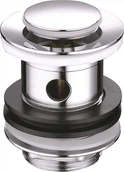In cold weather, insulating a sink drain is a crucial step to prevent freezing and potential damage. As a sink drain supplier, I've seen firsthand the problems that can arise when proper insulation isn't in place. In this blog, I'll share some effective methods to insulate your sink drain during the cold months.
Understanding the Need for Insulation
Before diving into the insulation methods, it's important to understand why it's necessary. When water in the sink drain freezes, it expands. This expansion can cause pipes to crack or burst, leading to costly repairs and water damage. Additionally, frozen pipes can block the flow of water, preventing proper drainage and causing backups in your sink.
Materials Needed
To insulate your sink drain, you'll need a few basic materials. These include pipe insulation sleeves, heat tape, and some basic tools like a utility knife and tape. Pipe insulation sleeves are typically made of foam or rubber and come in various sizes to fit different pipe diameters. Heat tape is an electrical heating element that can be wrapped around the pipes to keep them warm.
Step-by-Step Insulation Process
1. Prepare the Area
Start by turning off the water supply to the sink. This will prevent any water from flowing through the pipes while you're working on them. Next, clean the pipes thoroughly to remove any dirt, debris, or moisture. A clean surface will ensure better adhesion of the insulation materials.
2. Measure and Cut the Insulation Sleeves
Measure the length of the pipes that need to be insulated. Cut the pipe insulation sleeves to the appropriate length using a utility knife. Make sure to cut the sleeves slightly longer than the pipes to allow for some overlap at the joints.
3. Install the Insulation Sleeves
Slide the insulation sleeves over the pipes, starting from one end and working your way to the other. Make sure the sleeves fit snugly around the pipes and cover the entire length. Use tape to secure the sleeves in place at the joints and along the length of the pipes.
4. Apply Heat Tape (Optional)
If you live in an area with extremely cold temperatures, you may want to consider using heat tape. Wrap the heat tape around the pipes, following the manufacturer's instructions. Make sure to leave some space between the turns of the heat tape to allow for proper heat distribution. Connect the heat tape to a power source and test it to make sure it's working properly.
5. Seal the Joints
Use a sealant or caulk to seal any gaps or joints in the pipes. This will prevent cold air from seeping in and causing the pipes to freeze. Pay special attention to the areas where the pipes connect to the sink and the drain.
6. Check for Proper Installation
Once you've completed the insulation process, check the pipes to make sure the insulation is installed correctly. Look for any gaps, loose ends, or areas where the insulation may have been damaged. Make any necessary adjustments to ensure a tight fit.


Additional Tips
- Keep the Cabinet Doors Open: Keeping the cabinet doors under the sink open can help circulate warm air around the pipes and prevent them from freezing.
- Drip the Faucet: Allowing a small amount of water to drip from the faucet can help prevent the pipes from freezing. The constant flow of water will keep the pipes from getting too cold.
- Insulate the Sink Itself: Insulating the sink can also help keep the pipes warm. You can use a sink insulation pad or wrap the sink with insulation materials.
Our Sink Drain Products
As a sink drain supplier, we offer a wide range of high-quality sink drain products to meet your needs. Our products include Bottle Trap And Waste, Faucet With Pop Up Drain, and Extended Long Slotted Basin Waste. These products are designed to provide efficient drainage and are easy to install.
Contact Us for Purchase and Consultation
If you're interested in purchasing our sink drain products or need more information about sink drain insulation, please feel free to contact us. We have a team of experts who can provide you with professional advice and assistance. Whether you're a homeowner, a contractor, or a business owner, we're here to help you find the right solutions for your sink drain needs.
References
- "Pipe Insulation: A Guide to Keeping Your Pipes Warm in Winter." Home Improvement Magazine.
- "Preventing Frozen Pipes: Tips and Tricks." Plumbing Today.
- "The Importance of Sink Drain Insulation in Cold Weather." Building Science Journal.





